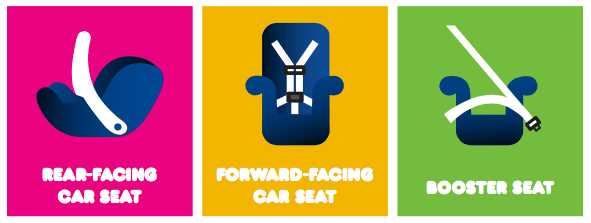
Together with the Ohio Department of Health's Ohio Buckles Buckeyes, Knox Public Health provides convertible and booster seats to income eligible families. Car seats are distributed by our Child Passenger Safety Technicians and are offered during scheduled classes. A $10 fee is recommended at the time of the class. Our Child Passenger Safety Technicians can also help you install a child car seat in your vehicle at no charge.
Who is eligible to receive a Child Passenger Safety Seat?
- Applicant must meet WIC income requirements.
- The child’s parent and/or guardian MUST attend a one–hour training program.
- The child must weigh 5–40 lbs. to receive the rear–facing/forward-facing (convertible seat) and must be 40-100 lbs. to receive a booster seat.
- The parent and/or guardian must provide proof of pregnancy or be in the third trimester to receive an infant seat. (when available)
- The child must be a resident of Knox County.
Car Seat Recommendations for Children
Birth – 12 Months
Your child under age 1 should always ride in a rear–facing car seat. There are different types of rear–facing car seats: Infant–only seats can only be used rear–facing. Convertible car seats typically have higher height and weight limits for the rear–facing position, allowing you to keep your child rear–facing for a longer period of time.
1 – 3 Years
Keep your child rear–facing as long as possible. The National Highway Traffic Safety Administration (NHTSA) and the American Academy of Pediatrics (AAP) both have released new recommendations to keep children rear–facing until age 2. It’s the best way to keep him or her safe. Your child should remain in a rear–facing car seat until he or she reaches the top height or weight limit allowed by your car seat’s manufacturer. Once your child outgrows the rear–facing car seat, your child is ready to travel in a forward–facing car seat with a harness.
4 – 7 Years
Keep your child in a forward–facing car seat with a harness until he or she reaches the top height or weight limit allowed by your car seat’s manufacturer. Once your child outgrows the forward–facing car seat with a harness, it’s time to travel in a booster seat, but still in the back seat.
8 – 12 Years
Keep your child in a booster seat until he or she is big enough to fit in a seat belt properly. Ohio’s Child Passenger Safety Law states that every child under 8 years old must ride in a booster seat or other appropriate child safety seat unless the child is 4’9” or taller. For a seat belt to fit properly the lap belt must lie snugly across the upper thighs, not the stomach. The shoulder belt should lie snug across the shoulder and chest and not cross the neck or face. Remember: your child should still ride in the back seat because it’s safer there.
Car Seat Chooser is provided by Nationwide Children's Hospital
Child Passenger Safety Restraint Types
Rear–Facing Car Seat
Is the best seat for your young child to use. It has a harness and in a crash, cradles and moves with your child to reduce the stress to the child’s fragile neck and spinal cord.
Forward–Facing Car Seat
Has a harness and tether that limits your child’s forward movement during a crash.
Booster Seat
Positions the seat belt so that it fits properly over the stronger parts of your child’s body.
Seat Belt
Should lie across the upper thighs and chest to restrain the child safely in a crash. It should not rest on the stomach area or across the neck.